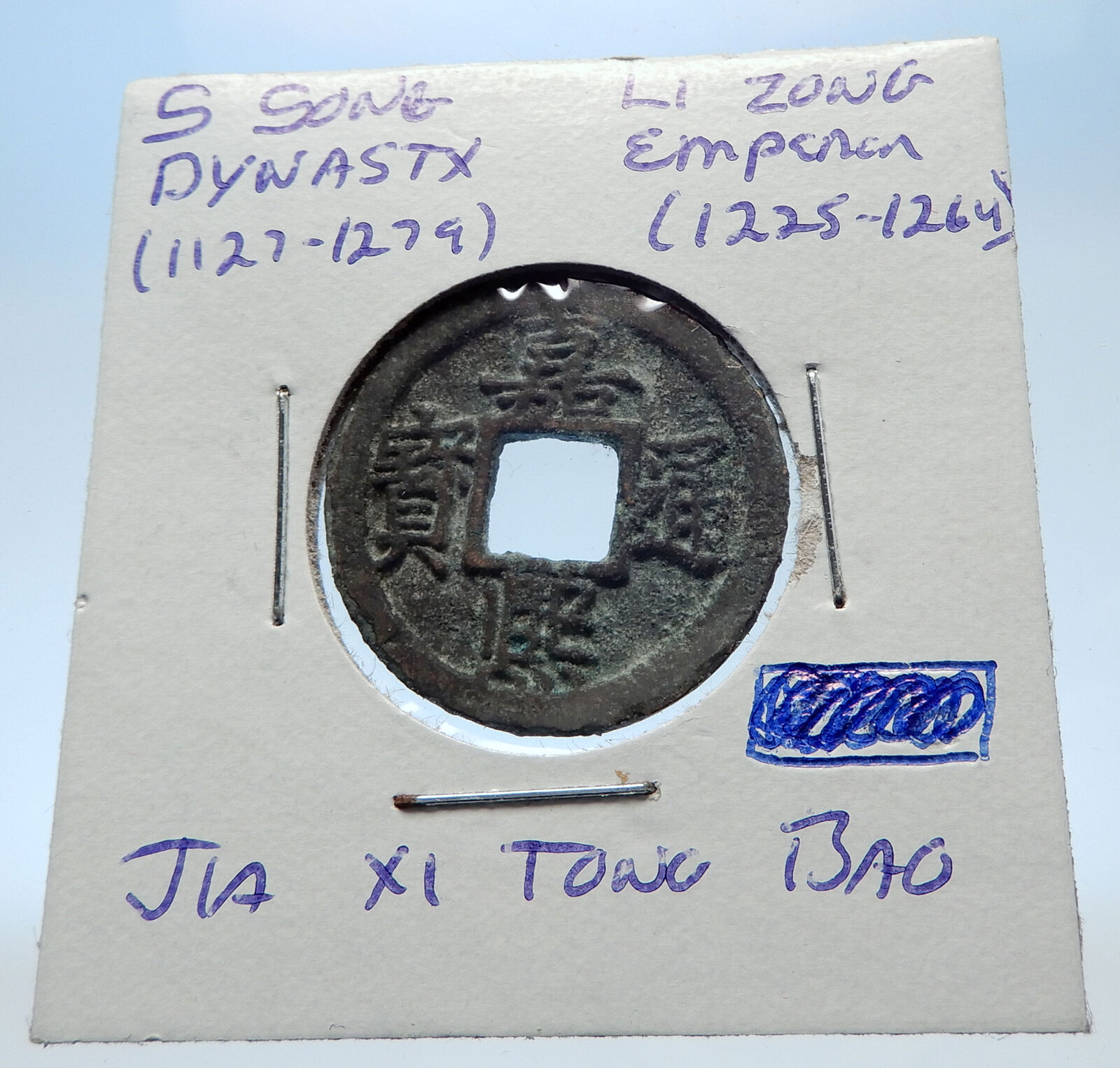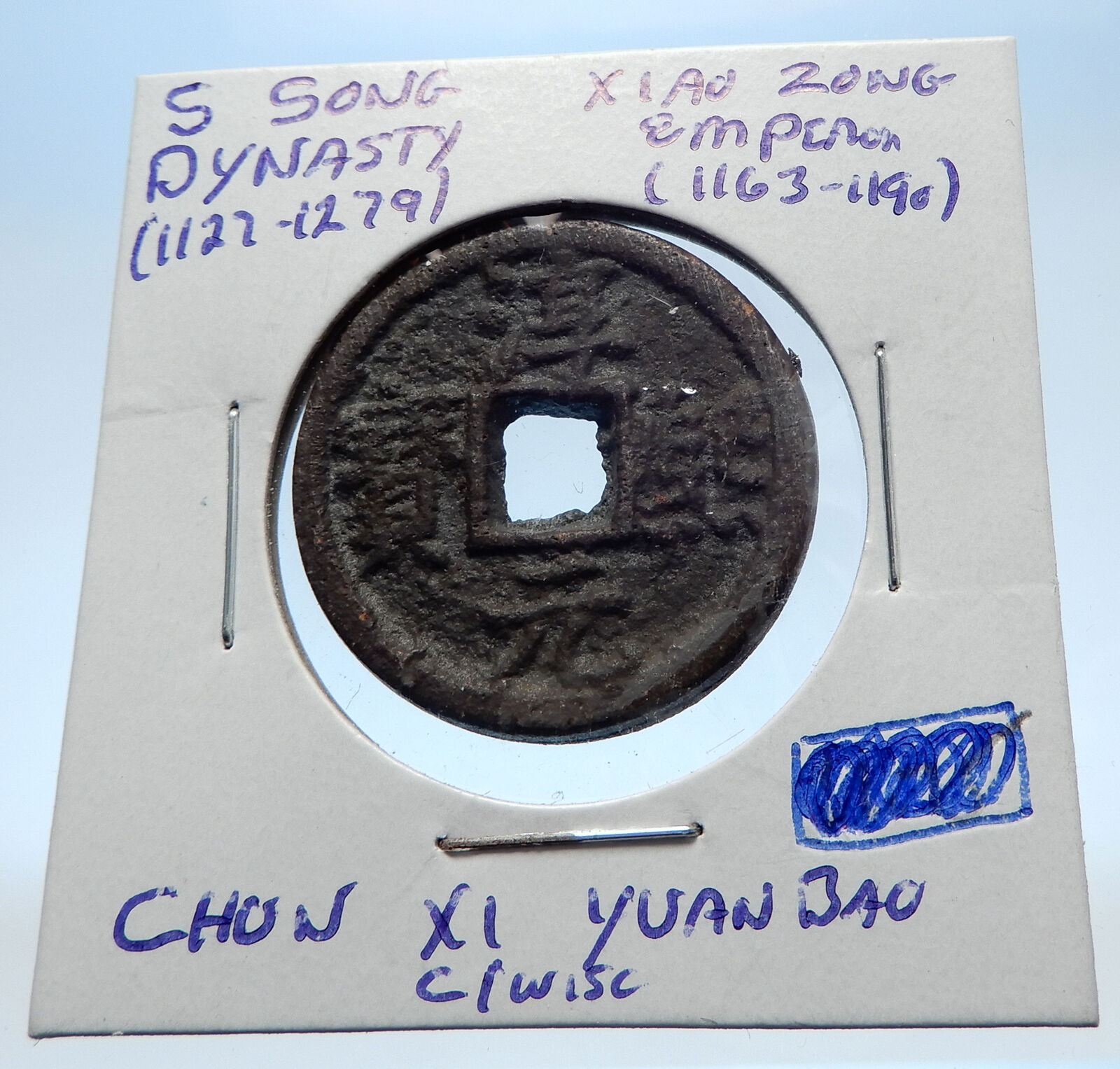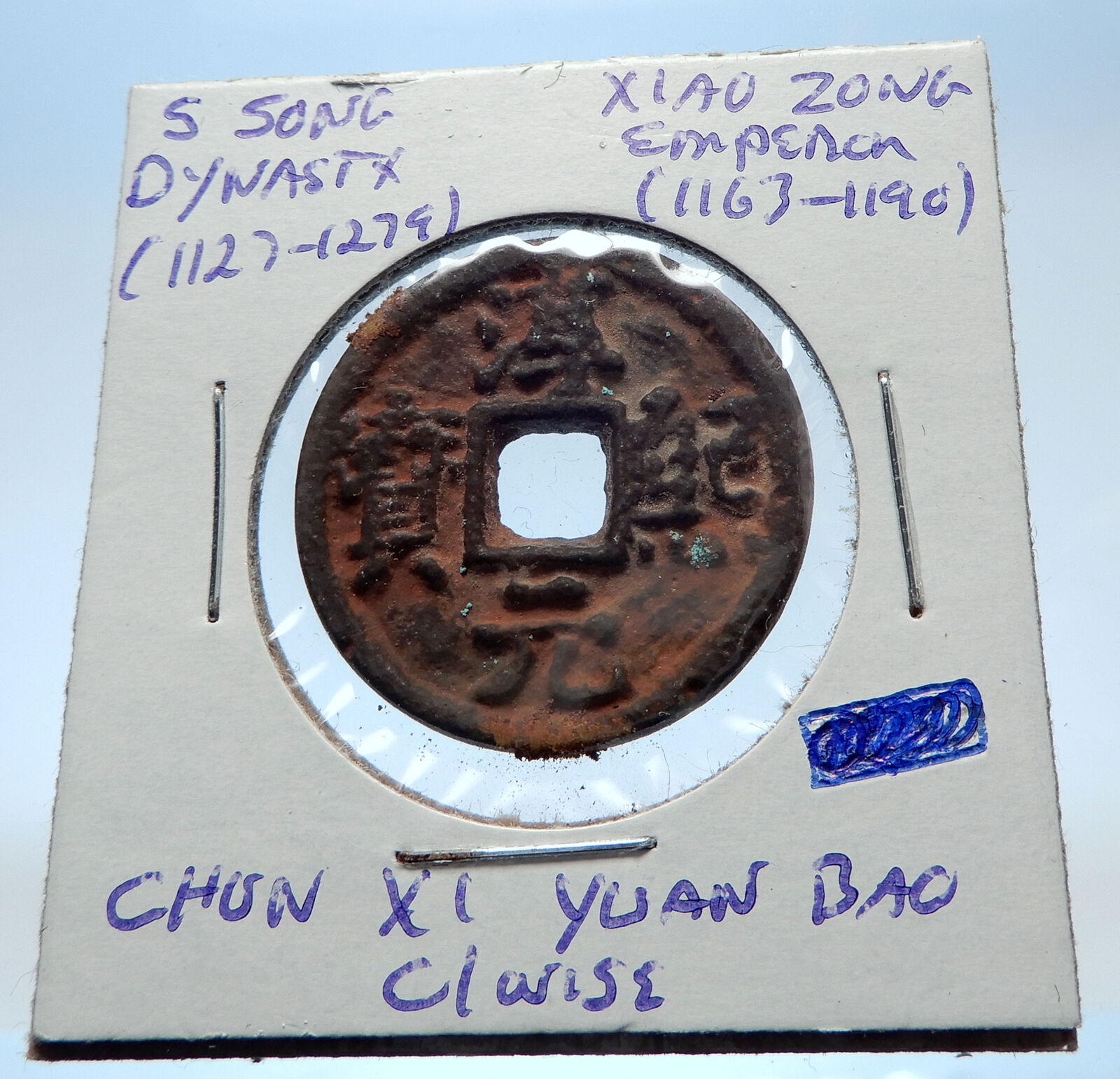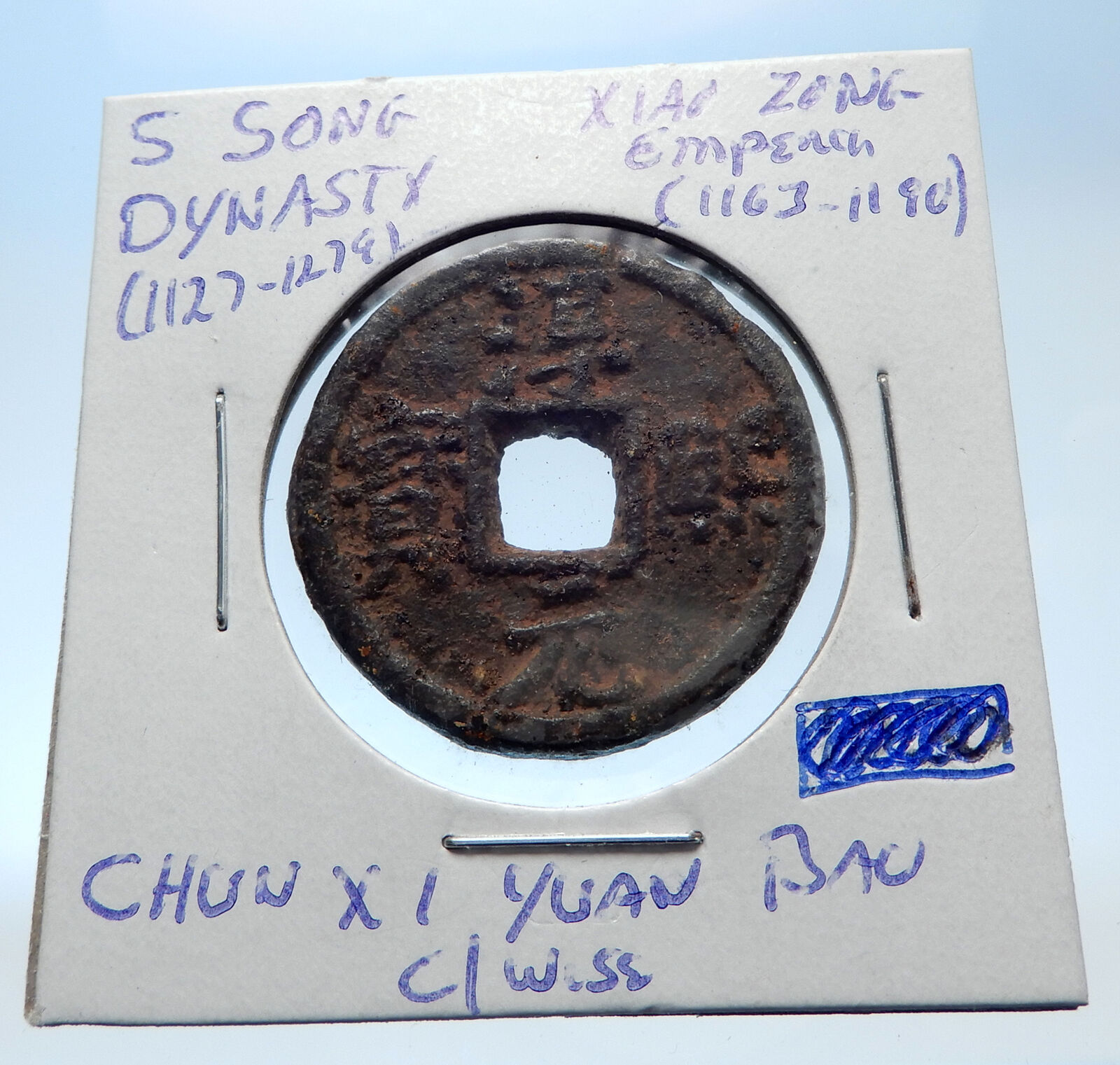|
China
Qing Dynasty under Guangxu – Emperor: 25 February 1875 – 14 November 1908
Hupeh Province
1902-1905 Copper 10 Cash 28mm (7.06 grams)
Reference: Y # 122 (1902-05)
造省北湖 光 寶元 緒 十當, Four Chinese ideograms read top to bottom, right to left with flower in the centre, all with Manchu characters on either side and more Chinese ideograms above and below.
PEH PROVINCE TEN CASH, Dragon with pearl at centre and mountain below.
You are bidding on the exact item pictured, provided with a Certificate of Authenticity and Lifetime Guarantee of Authenticity.
 The Guangxu Emperor (14 August 1871 – 14 November 1908), personal name Zaitian, was the tenth Emperor of the Qing dynasty, and the ninth Qing emperor to rule over China proper. His reign lasted from 1875 to 1908, but in practice he ruled, without Empress Dowager Cixi’s influence, only from 1889 to 1898. He initiated the Hundred Days’ Reform, but was abruptly stopped when the empress dowager launched a coup in 1898, after which he became powerless and was held under house arrest until his death. His era name, “Guangxu”, means “glorious succession”. The Guangxu Emperor (14 August 1871 – 14 November 1908), personal name Zaitian, was the tenth Emperor of the Qing dynasty, and the ninth Qing emperor to rule over China proper. His reign lasted from 1875 to 1908, but in practice he ruled, without Empress Dowager Cixi’s influence, only from 1889 to 1898. He initiated the Hundred Days’ Reform, but was abruptly stopped when the empress dowager launched a coup in 1898, after which he became powerless and was held under house arrest until his death. His era name, “Guangxu”, means “glorious succession”.
The emperor died in 1908 and it was widely suspected at the time that he had been poisoned. A forensic examination on his remains confirmed in 2008 that the cause of death was arsenic poisoning. The level of arsenic in his remains was 2,000 times higher than normal.
Even after the Guangxu Emperor began formal rule, Empress Dowager Cixi continued to influence his decisions and actions, despite residing several months of the year at the Summer Palace. Weng Tonghe reportedly observed that while the emperor attended to day-to-day state affairs, in more difficult cases the emperor and the Grand Council sought Cixi’s advice. In fact, the emperor often journeyed to the Summer Palace to pay his respects to his aunt and to discuss state affairs with her.
In March 1891, the Guangxu Emperor received the foreign ministers to China at an audience in the “Pavilion of Purple Light”, in what is now part of Zhongnanhai, something that had also been done by the Tongzhi Emperor in 1873. That summer, under pressure from the foreign legations and in response to revolts in the Yangtze River valley that were targeting Christian missionaries, the emperor issued an edict ordering Christians to be placed under state protection.
The Guangxu Emperor, while growing up, apparently had been instilled with the importance of frugality. In 1892, he tried to implement a series of draconian measures to reduce expenditures by the Imperial Household Department, which proved to be one of his few administrative successes. But it was only a partial victory, as he had to approve higher expenditures than he would have liked to meet Cixi’s needs.
1894 saw the outbreak of the First Sino-Japanese War. During the war, even though the Guangxu Emperor was nominally the sovereign ruler of the Qing Empire, officials often ignored him and instead sent their memorials to Cixi for her approval. Eventually, two sets of Grand Council memoranda were created, one for the emperor and the other for the empress dowager, a practice that continued until it was rendered unnecessary by the events in the autumn of 1898. Following the Qing Empire’s defeat and forced agreement to the terms of the Treaty of Shimonoseki, the Guangxu Emperor reportedly expressed his wish to abdicate. The emperor and the Qing government faced further humiliation in late 1897 when the German Empire used the murders of two priests in Shandong Province as an excuse to occupy Jiaozhou Bay, prompting a “scramble for concessions” by other foreign powers.
Following the war and the scramble for concessions, the Guangxu Emperor came to believe that by learning from constitutional monarchies like Japan, the Qing Empire would become more politically and economically powerful. In June 1898, the emperor began the Hundred Days’ Reform, aimed at a series of sweeping political, legal and social changes. For a brief time, after Cixi’s supposed retirement, the Guangxu Emperor issued edicts for a massive number of far-reaching modernizing reforms with the help of more progressive officials such as Kang Youwei and Liang Qichao.
Changes ranged from infrastructure to industry and the civil examination system. The Guangxu Emperor issued decrees allowing the establishment of a modern university in Beijing, the construction of the Lu-Han railway, and a system of budgets similar to that of Western governments. The initial goal was to make China a modern constitutional empire, but still within the traditional framework, as with Japan’s Meiji Restoration.
The reforms, however, were not only too sudden for a China still under significant neo-Confucian influence and other elements of traditional culture, but also came into conflict with Cixi, who held real power. Many officials, deemed useless and dismissed by the Guangxu Emperor, begged her for help. Although Cixi did nothing to stop the Hundred Days’ Reform from taking place, she knew the only way to secure her power base was to stage a military coup. The Guangxu Emperor became aware of such a plan, so he asked Kang Youwei and his reformist allies to plan his rescue. They decided to use the help of Yuan Shikai, who had a modernized army, albeit only 6,000-strong. Cixi relied on Ronglu’s army in Tianjin.
Ronglu also had an ally, General Dong Fuxiang, who commanded 10,000 Muslim Kansu Braves, including generals such as Ma Fuxiang and Ma Fulu, stationed in the Beijing metropolitan area. Armed with more advanced firearms and artillery, they sided with Cixi’s conservative faction during the coup.
The day before the staged coup was supposed to take place, Yuan Shikai revealed everything to Ronglu, exposing the Guangxu Emperor’s plans. This gained Yuan Shikai the trust of Cixi, as well as the status of lifetime enemy of the Guangxu Emperor as well as the emperor’s younger half-brother, Zaifeng. Following the exposure of the plot, the emperor and empress dowager met, and the emperor retreated to the Yingtai Pavilion, a palace on a lake that is now part of the Zhongnanhai Compound.
Lei Chia-sheng (雷家聖), a Taiwanese history professor, proposes an alternative view: that the Guangxu Emperor might have been led into a trap by the reformists led by Kang Youwei, who in turn was in Lei’s opinion tricked by British missionary Timothy Richard and former Japanese prime minister Itō Hirobumi into agreeing to appoint Itō as one of many foreign advisors. British ambassador Claude MacDonald claimed that the reformists had actually “much injured” the modernization of China. Lei claims that Cixi learned of the plot and decided to put an end to it to prevent China from coming under foreign control.
 China, officially the People’s Republic of China (PRC) since 1949, is a country in East Asia and the world’s most populous country, with a population of around 1.404 billion. Covering approximately 9,600,000 square kilometers (3,700,000 sq mi), it is the third- or fourth-largest country by total area, depending on the source consulted. Governed by the Communist Party of China, the state exercises jurisdiction over 22 provinces, five autonomous regions, four direct-controlled municipalities (Beijing, Tianjin, Shanghai, and Chongqing), and the special administrative regions of Hong Kong and Macau. China, officially the People’s Republic of China (PRC) since 1949, is a country in East Asia and the world’s most populous country, with a population of around 1.404 billion. Covering approximately 9,600,000 square kilometers (3,700,000 sq mi), it is the third- or fourth-largest country by total area, depending on the source consulted. Governed by the Communist Party of China, the state exercises jurisdiction over 22 provinces, five autonomous regions, four direct-controlled municipalities (Beijing, Tianjin, Shanghai, and Chongqing), and the special administrative regions of Hong Kong and Macau.
.svg/85px-National_Emblem_of_the_People's_Republic_of_China_(2).svg.png) China emerged as one of the world’s earliest civilizations, in the fertile basin of the Yellow River in the North China Plain. For millennia, China’s political system was based on hereditary monarchies, or dynasties, beginning with the semi-legendary Xia dynasty in 21st century BCE. Since then, China has expanded, fractured, and re-unified numerous times. In the 3rd century BCE, the Qin unified core China and established the first Chinese empire. The succeeding Han dynasty, which ruled from 206 BC until 220 AD, saw some of the most advanced technology at that time, including papermaking and the compass, along with agricultural and medical improvements. The invention of gunpowder and movable type in the Tang dynasty (618-907) and Northern Song (960-1127) completed the Four Great Inventions. Tang culture spread widely in Asia, as the new maritime Silk Route brought traders to as far as Mesopotamia and Horn of Africa. Dynastic rule ended in 1912 with the Xinhai Revolution, when a republic replaced the Qing dynasty. The Chinese Civil War resulted in a division of territory in 1949, when the Communist Party of China established the People’s Republic of China, a unitary one-party sovereign state on Mainland China, while the Kuomintang-led government retreated to the island of Taiwan. The political status of Taiwan remains disputed. China emerged as one of the world’s earliest civilizations, in the fertile basin of the Yellow River in the North China Plain. For millennia, China’s political system was based on hereditary monarchies, or dynasties, beginning with the semi-legendary Xia dynasty in 21st century BCE. Since then, China has expanded, fractured, and re-unified numerous times. In the 3rd century BCE, the Qin unified core China and established the first Chinese empire. The succeeding Han dynasty, which ruled from 206 BC until 220 AD, saw some of the most advanced technology at that time, including papermaking and the compass, along with agricultural and medical improvements. The invention of gunpowder and movable type in the Tang dynasty (618-907) and Northern Song (960-1127) completed the Four Great Inventions. Tang culture spread widely in Asia, as the new maritime Silk Route brought traders to as far as Mesopotamia and Horn of Africa. Dynastic rule ended in 1912 with the Xinhai Revolution, when a republic replaced the Qing dynasty. The Chinese Civil War resulted in a division of territory in 1949, when the Communist Party of China established the People’s Republic of China, a unitary one-party sovereign state on Mainland China, while the Kuomintang-led government retreated to the island of Taiwan. The political status of Taiwan remains disputed.
.svg/220px-People's_Republic_of_China_(orthographic_projection).svg.png) Since the introduction of economic reforms in 1978, China’s economy has been one of the world’s fastest-growing with annual growth rates consistently above 6 percent. As of 2016, it is the world’s second-largest economy by nominal GDP and largest by purchasing power parity (PPP). China is also the world’s largest exporter and second-largest importer of goods. China is a recognized nuclear weapons state and has the world’s largest standing army and second-largest defense budget. The PRC is a permanent member of the United Nations Security Council as it replaced the ROC in 1971, as well as an active global partner of ASEAN Plus mechanism. China is also a leading member of numerous formal and informal multilateral organizations, including the Shanghai Cooperation Organization (SCO), WTO, APEC, BRICS, the BCIM, and the G20. China is a great power and a major regional power within Asia, and has been characterized as a potential superpower. Since the introduction of economic reforms in 1978, China’s economy has been one of the world’s fastest-growing with annual growth rates consistently above 6 percent. As of 2016, it is the world’s second-largest economy by nominal GDP and largest by purchasing power parity (PPP). China is also the world’s largest exporter and second-largest importer of goods. China is a recognized nuclear weapons state and has the world’s largest standing army and second-largest defense budget. The PRC is a permanent member of the United Nations Security Council as it replaced the ROC in 1971, as well as an active global partner of ASEAN Plus mechanism. China is also a leading member of numerous formal and informal multilateral organizations, including the Shanghai Cooperation Organization (SCO), WTO, APEC, BRICS, the BCIM, and the G20. China is a great power and a major regional power within Asia, and has been characterized as a potential superpower.
|





 The Guangxu Emperor (14 August 1871 – 14 November 1908), personal name Zaitian, was the tenth Emperor of the Qing dynasty, and the ninth Qing emperor to rule over China proper. His reign lasted from 1875 to 1908, but in practice he ruled, without Empress Dowager Cixi’s influence, only from 1889 to 1898. He initiated the Hundred Days’ Reform, but was abruptly stopped when the empress dowager launched a coup in 1898, after which he became powerless and was held under house arrest until his death. His era name, “Guangxu”, means “glorious succession”.
The Guangxu Emperor (14 August 1871 – 14 November 1908), personal name Zaitian, was the tenth Emperor of the Qing dynasty, and the ninth Qing emperor to rule over China proper. His reign lasted from 1875 to 1908, but in practice he ruled, without Empress Dowager Cixi’s influence, only from 1889 to 1898. He initiated the Hundred Days’ Reform, but was abruptly stopped when the empress dowager launched a coup in 1898, after which he became powerless and was held under house arrest until his death. His era name, “Guangxu”, means “glorious succession”. China, officially the People’s Republic of China (PRC) since 1949, is a country in East Asia and the world’s most populous country, with a population of around 1.404 billion. Covering approximately 9,600,000 square kilometers (3,700,000 sq mi), it is the third- or fourth-largest country by total area, depending on the source consulted. Governed by the Communist Party of China, the state exercises jurisdiction over 22 provinces, five autonomous regions, four direct-controlled municipalities (Beijing, Tianjin, Shanghai, and Chongqing), and the special administrative regions of Hong Kong and Macau.
China, officially the People’s Republic of China (PRC) since 1949, is a country in East Asia and the world’s most populous country, with a population of around 1.404 billion. Covering approximately 9,600,000 square kilometers (3,700,000 sq mi), it is the third- or fourth-largest country by total area, depending on the source consulted. Governed by the Communist Party of China, the state exercises jurisdiction over 22 provinces, five autonomous regions, four direct-controlled municipalities (Beijing, Tianjin, Shanghai, and Chongqing), and the special administrative regions of Hong Kong and Macau. .svg/85px-National_Emblem_of_the_People's_Republic_of_China_(2).svg.png) China emerged as one of the world’s earliest civilizations, in the fertile basin of the Yellow River in the North China Plain. For millennia, China’s political system was based on hereditary monarchies, or dynasties, beginning with the semi-legendary Xia dynasty in 21st century BCE. Since then, China has expanded, fractured, and re-unified numerous times. In the 3rd century BCE, the Qin unified core China and established the first Chinese empire. The succeeding Han dynasty, which ruled from 206 BC until 220 AD, saw some of the most advanced technology at that time, including papermaking and the compass, along with agricultural and medical improvements. The invention of gunpowder and movable type in the Tang dynasty (618-907) and Northern Song (960-1127) completed the Four Great Inventions. Tang culture spread widely in Asia, as the new maritime Silk Route brought traders to as far as Mesopotamia and Horn of Africa. Dynastic rule ended in 1912 with the Xinhai Revolution, when a republic replaced the Qing dynasty. The Chinese Civil War resulted in a division of territory in 1949, when the Communist Party of China established the People’s Republic of China, a unitary one-party sovereign state on Mainland China, while the Kuomintang-led government retreated to the island of Taiwan. The political status of Taiwan remains disputed.
China emerged as one of the world’s earliest civilizations, in the fertile basin of the Yellow River in the North China Plain. For millennia, China’s political system was based on hereditary monarchies, or dynasties, beginning with the semi-legendary Xia dynasty in 21st century BCE. Since then, China has expanded, fractured, and re-unified numerous times. In the 3rd century BCE, the Qin unified core China and established the first Chinese empire. The succeeding Han dynasty, which ruled from 206 BC until 220 AD, saw some of the most advanced technology at that time, including papermaking and the compass, along with agricultural and medical improvements. The invention of gunpowder and movable type in the Tang dynasty (618-907) and Northern Song (960-1127) completed the Four Great Inventions. Tang culture spread widely in Asia, as the new maritime Silk Route brought traders to as far as Mesopotamia and Horn of Africa. Dynastic rule ended in 1912 with the Xinhai Revolution, when a republic replaced the Qing dynasty. The Chinese Civil War resulted in a division of territory in 1949, when the Communist Party of China established the People’s Republic of China, a unitary one-party sovereign state on Mainland China, while the Kuomintang-led government retreated to the island of Taiwan. The political status of Taiwan remains disputed. .svg/220px-People's_Republic_of_China_(orthographic_projection).svg.png) Since the introduction of economic reforms in 1978, China’s economy has been one of the world’s fastest-growing with annual growth rates consistently above 6 percent. As of 2016, it is the world’s second-largest economy by nominal GDP and largest by purchasing power parity (PPP). China is also the world’s largest exporter and second-largest importer of goods. China is a recognized nuclear weapons state and has the world’s largest standing army and second-largest defense budget. The PRC is a permanent member of the United Nations Security Council as it replaced the ROC in 1971, as well as an active global partner of ASEAN Plus mechanism. China is also a leading member of numerous formal and informal multilateral organizations, including the Shanghai Cooperation Organization (SCO), WTO, APEC, BRICS, the BCIM, and the G20. China is a great power and a major regional power within Asia, and has been characterized as a potential superpower.
Since the introduction of economic reforms in 1978, China’s economy has been one of the world’s fastest-growing with annual growth rates consistently above 6 percent. As of 2016, it is the world’s second-largest economy by nominal GDP and largest by purchasing power parity (PPP). China is also the world’s largest exporter and second-largest importer of goods. China is a recognized nuclear weapons state and has the world’s largest standing army and second-largest defense budget. The PRC is a permanent member of the United Nations Security Council as it replaced the ROC in 1971, as well as an active global partner of ASEAN Plus mechanism. China is also a leading member of numerous formal and informal multilateral organizations, including the Shanghai Cooperation Organization (SCO), WTO, APEC, BRICS, the BCIM, and the G20. China is a great power and a major regional power within Asia, and has been characterized as a potential superpower. 




